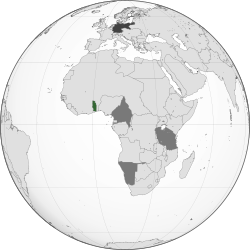
Back توغولاند Arabic Тогаленд Byelorussian Тоголанд Bulgarian Protectorat alemany del Togo Catalan Togoland Czech Togoland Almaenig Welsh Togoland Danish Togo (Kolonie) German Τογκολάνδη Greek Germana Togolando Esperanto
Togoland Protectorate Schutzgebiet Togo (German) | |||||||||
|---|---|---|---|---|---|---|---|---|---|
| 1884–1914[1] | |||||||||
 Green: Territory comprising the German colony of Togoland Dark grey: Other German possessions Darkest grey: German Empire | |||||||||
| Status | Protectorate of German Empire | ||||||||
| Capital | Bagida (1884–87) Sebeab (1887–97) Lomé (1897–1916) | ||||||||
| Common languages | German (official) Ewe, Kotokoli, Kabye | ||||||||
| Religion | Islam, Christianity, Traditional religion | ||||||||
| Governor | |||||||||
• 1884 (first) | Gustav Nachtigal | ||||||||
• 1914 (last) | Hans Georg von Doering | ||||||||
| Historical era | New Imperialism | ||||||||
| 5 July 1884 | |||||||||
| 26 August 1914 | |||||||||
• Togoland partitioned | 27 December 1916 | ||||||||
| Area | |||||||||
| 1912 | 87,200 km2 (33,700 sq mi) | ||||||||
| Population | |||||||||
• 1912 | 1,000,000 | ||||||||
| Currency | German gold mark | ||||||||
| |||||||||
| Today part of | Ghana Togo | ||||||||
Togoland, officially the Togoland Protectorate (German: Schutzgebiet Togo; French: Protectorat du Togo), was a protectorate of the German Empire in West Africa from 1884 to 1914, encompassing what is now the nation of Togo and most of what is now the Volta Region of Ghana, approximately 90,400 km2 (29,867 sq mi) in size.[2][3] During the period known as the "Scramble for Africa", the colony was established in 1884 and was gradually extended inland.
At the outbreak of the First World War in 1914, the colony was invaded and quickly overrun by British and French forces during the Togoland campaign and placed under military rule. In 1916 the territory was divided into separate British and French administrative zones, and this was formalised in 1922 with the creation of British Togoland and French Togoland.
- ^ Laumann (2003), pp. 195–199
- ^ "Rank Order – Area". CIA World Fact Book. Archived from the original on June 13, 2007. Retrieved 12 April 2008.
- ^ David Owusu-Ansah. Historical Dictionary of Ghana (4 ed.). Rowman & Littlefield. p. xii.

